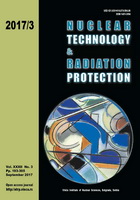
THE EXPERIMENTAL STUDY OF RESIDUAL RADIOACTIVITY INDUCED IN ELECTROSTATIC DEFLECTOR

Vol.
XXXII, No. 3, Pp. 193-305
September 2017
UDC 621.039+614.876:504.06
ISSN 1451-3994
Pages: 211-216
Authors: Chong Xu, Wuyuan Li, Junkui Xu, Yao Yang, Wang Mao, Weiwei Yan, Youwu Su,
and Yaqing YangAbstract
As one of the key components of Sector Focusing Cyclotron at the Institute of Modern Physics, Chinese Academy of Sciences, the electrostatic deflector can be activated by primary and secondary particles, because of a mismatch between the actual value and the design value of the emittance and emergence angle. In addition, it will be struck by more particles, since there is a stray magnetic field and outgas from the surface of the electrostatic deflector. The residual radioactivity in the electrostatic deflector has been studied in two aspects: specific activity and residual dose rate, based on the gamma-ray spectrometry and Fluke 451p ionization chamber, respectively. The specific activity of radionuclides in the main components and the dust on the enclosure have been investigated by using gamma-ray spectrometry. The residual dose rate around the electrostatic deflector has been obtained by Fluke 451p ionization chamber. The results of the study show that there is a non-negligible radiological risk to the staff. This result can be provided as guidance for making a maintenance schedule, so that the dose received by staff can be kept as low as reasonably achievable. Based on the results, advice for "hands-on" maintenance and decommissioning of the SFC have been provided.
Key words: electrostatic deflector, accelerator, induced radioactivity, specific activity, radionuclide
FULL PAPER IN PDF FORMAT (597 KB)